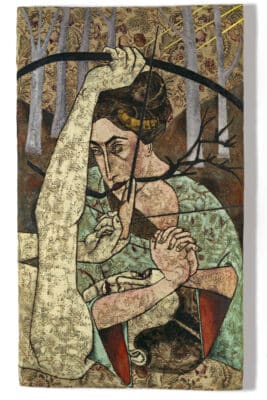Image: Golden Dream by Mousumi Biswas, 2016, Oil on canvas, 24 x 36 in. (Courtesy of author)
Women artists have been vanguards of shaping the narrative of contemporary arts in India. With their practices rooted in expressing the dilemmas and issues of the world surrounding them, these path-breaking women artists have created landmark works that sparked innovative trends and movements in the art world. Expressing their distinct sensibilities by experimenting with various mediums, women artists have consistently commanded critical acclaim for their work across the world. Here are some of the leading women artists who have shaped the narrative of contemporary art in India in present times.
Anju Dodiya: Anju Dodiya was born in Mumbai and graduated with a Diploma in Fine Arts from Sir J. J. School of Art, Mumbai in 1986. She is renowned for her ‘fictional self-portraits’ that explore the conflict between the inner self and external reality. Her works, often auto-biographical in nature, give the viewer a glimpse into the life of the protagonist and reveal a process of self-discovery and introspection. A dedicated watercolourist, Anju Dodiya often experiments with different mediums and textures. Layering her paintings with symbolism, she draws inspiration from artists such as poet Sylvia Plath, filmmaker Ingmar Bergman as well as Early Renaissance masters like Piero della Francesca and Giotto. She has expanded her visual vocabulary over the decades and experimented with multi-media and site-specific installations.

Bharti Kher: Bharti Kher is one of the most prominent contemporary artists in India whose oeuvre ranges from painting, sculpture to installation. Her work explores the interlocking relationship between humans, animals, places and objects while deconstructing the notion of self. She works in an exploratory style, surveying, looking and collecting objects and transforming them into art. Her work, which is loaded with symbolism, serves as an attempt at initiating a dialogue between the metaphysical and material pursuits of life through the eyes of the viewer. It offers a sense of magic realism through its portrayal of daily life and rituals and tries to build a relationship with the viewer. In her three-decade long career, Bharti Kher has worked with a wide range of materials—from fibreglass, fabric, resin, metal and mirrors. However, she is most renowned for her signature use of the ‘bindi’ in her works. It first started appearing in her work in 1995 and since then, has become a leitmotif of her work and style.

Rekha Rodwittiya: Rekha Rodwittiya’s art delves into the multifaceted aspects of life, including issues of alienation and belonging, discrimination and acceptance, and harmony and discord. As a sensitive artist, she is keenly aware of the socio-political attitudes that surround her and responds to them in a pragmatic manner. Her work reflects her sensitivity to these attitudes, as well as her personal experiences. Rodwittiya does not view art as existing in isolation from life, and believes that one must experience life in order to create meaningful art. Her passion for painting is a struggle for her own rightful existence, as she undergoes the terror and agony of exploring the unknown. Her images are a reflection of her thoughts, emotions, beliefs, values, and vast collection of past experiences. The artist draws on elemental imagery that is imbued with psychological insights, using it to portray women through the lens of personal experience and everyday realities.

Mousumi Biswas: Mousumi Biswas was born in Kolkata in 1978. She completed her Bachelor’s in Visual Art from the Govt. College of Art and Craft in Kolkata, and a Master in Fine Arts from Kala Bhavan, Visva Bharati, Santiniketan in 2005. Mousumi is a versatile artist who works with painting and sculpture. Her works are known for their eye-catching colours and their vibrant composition. Her version of ‘Afghan Girl’ is particularly interesting in its interpretation of the original work, which appeared on the cover of National Geographic magazine. She has been experimenting with fibreglass to create sculptures painted in high gloss. Her choice of colour tones and subjects is the most striking and aesthetically appealing aspect of her work. She often uses birds and animals as recurrent subjects for her sculptures.
Nidhi Agarwal: Nidhi Agarwal is a contemporary Indian artist known for her vibrant and colourful abstract paintings. Born in Faridabad, Haryana in 1972, she developed a deep appreciation for the country’s rich cultural heritage, which influences her work today. She studied painting at the College of Art in New Delhi after which she started creating renowned works in various mediums. Agarwal’s unique style is characterised by her use of bold colours, fluid lines, and organic forms. She paints with a confident hand, using brushstrokes that are both playful and energetic. Her Abstract Expressionist works are humorous while being rebellious and addressing issues that plague Indian society. She delves into these with ‘organisms’ of her own creation that stem from her imagination. She is well known for her thick impasto technique that creates multiple textures lending to the works’ vibrancy. She also dabbles with various mediums. Among her many inspirations are artists Basquiat and Tyeb Mehta.
Meetali Singh: Artist Meetali Singh proclaims that she does not belong to any particular school of art, and does not believe in making a statement through art. She tries to fathom ‘what I am as an individual’, albeit neither in any particular socio-political context nor in context of my immediate milieu. Painting for her is a quest to answer self-posed queries. She lives and works in Vadodara.

Observer Voice is the one stop site for National, International news, Editor’s Choice, Art/culture contents, Quotes and much more. We also cover historical contents. Historical contents includes World History, Indian History, and what happened today. The website also covers Entertainment across the India and World.










